Long-Term Characteristics of Severe COVID-19: Respiratory Function, Functional Capacity, and Quality of Life
Abstract
:1. Introduction
2. Materials and Methods
2.1. Participants
2.2. Experimental Protocol
2.2.1. Modified Medical Research Council (MMRC) Dyspnea Scale
2.2.2. Lung Function Test
2.2.3. Respiratory Muscle Strength
2.2.4. Peripheral Muscle Strength
2.2.5. Evaluation of Functional Capacity
2.2.6. Balance Evaluation
2.2.7. Hospital Anxiety and Depression Scale (HADS)
2.2.8. Mini-Mental State Test
2.2.9. Fatigue Severity Scale (FSS)
2.2.10. International Physical Activity Questionnaire (IPAQ) Short Form
2.2.11. St. George Respiratory Questionnaire (SGRQ) and Nottingham Health Profile (NHP)
2.3. Statistical Analysis
3. Results
3.1. Participant Characteristics
3.2. Lung Function Test
3.3. Respiratory and Peripheral Muscle Strength
3.4. Functional Capacity Evaluation
3.5. Balance Evaluation
3.6. Hospital Anxiety and Depression Scale (HADS), Fatigue Severity Scale (FSS), and Mini-Mental Test (MMST)
3.7. International Physical Activity Questionnaire (IPAQ) Short Form, St George Respiratory Questionnaire (SGRQ), and Nottingham Health Profile (NHP)
3.8. Conditions of Those Receiving Corticosteroid and Mechanical Ventilation in the COVID-19 Group
3.9. Relationship between the Length of ICU Stay, APACHE II, and TUG Scores with the Measured Parameters
3.10. Laboratory Changes in Patients with COVID-19
3.11. Relationship between CRP and LDH with FVC, 6MWT Distance, Dyspnea, and SGRQ Total Score
3.12. Relationship between SGRQ Total Score and NHP Total Score with Dyspnea (Borg, after 6MWT), HADS, and FSS
4. Discussion
5. Conclusions
Author Contributions
Funding
Institutional Review Board Statement
Informed Consent Statement
Data Availability Statement
Conflicts of Interest
References
- Gattinoni, L.; Coppola, S.; Cressoni, M.; Busana, M.; Rossi, S.; Chiumello, D. COVID-19 Does Not Lead to a ‘Typical’ Acute Respiratory Distress Syndrome. Am. J. Respir. Crit. Care Med. 2020, 201, 1299–1300. [Google Scholar] [CrossRef] [PubMed] [Green Version]
- Dara, N.; Hosseini, A.; Sayyari, A.A.; Gaman, M.A.; Fatahi, S. Gastrointestinal Manifestations and Dynamics of Liver Enzymes in Children and Adolescents with COVID-19 Infection: A Systematic Review and Meta-Analysis. Iran. J. Pediatr. 2020, 30, 1–9. [Google Scholar] [CrossRef]
- Yin, S.; Huang, M.; Li, D.; Tang, N. Difference of Coagulation Features between Severe Pneumonia Induced by SARS-CoV2 and Non-SARS-CoV2. J. Thromb. Thrombolysis 2021, 51, 1107–1110. [Google Scholar] [CrossRef] [PubMed] [Green Version]
- Guan, W.; Ni, Z.; Hu, Y.; Liang, W.; Ou, C.; He, J.; Liu, L.; Shan, H.; Lei, C.; Hui, D.S.C. Clinical Characteristics of Coronavirus Disease 2019 in China. N. Engl. J. Med. 2020, 382, 1708–1720. [Google Scholar] [CrossRef]
- Fara, A.; Mitrev, Z.; Rosalia, R.A.; Assas, B.M. Cytokine Storm and COVID-19: A Chronicle of pro-Inflammatory Cytokines. Open. Biol. 2020, 10, 200160. [Google Scholar] [CrossRef]
- Giannis, D.; Ziogas, I.A.; Gianni, P. Coagulation Disorders in Coronavirus Infected Patients: COVID-19, SARS-CoV-1, MERS-CoV and Lessons from the Past. J. Clin. Virol. 2020, 127, 104362. [Google Scholar] [CrossRef]
- Klok, F.A.; Boon, G.J.A.M.; Barco, S.; Endres, M.; Geelhoed, J.J.M.; Knauss, S.; Rezek, S.A.; Spruit, M.A.; Vehreschild, J.; Siegerink, B. The Post-COVID-19 Functional Status Scale: A Tool to Measure Functional Status over Time after COVID-19. Eur. Respir. J. 2020, 56, 2001494. [Google Scholar] [CrossRef]
- Eapen, M.S.; Lu, W.; Gaikwad, A.V.; Bhattarai, P.; Chia, C.; Hardikar, A.; Haug, G.; Sohal, S.S. Endothelial to Mesenchymal Transition: A Precursor to Post-COVID-19 Interstitial Pulmonary Fibrosis and Vascular Obliteration? Eur. Respir. J. 2020, 56, 2003167. [Google Scholar] [CrossRef]
- Hermans, G.; Van Den Berghe, G. Clinical Review: Intensive Care Unit Acquired Weakness. Crit. Care. 2015, 5, 274. [Google Scholar] [CrossRef] [Green Version]
- Torres-Castro, R.; Vasconcello-Castillo, L.; Alsina-Restoy, X.; Solis-Navarro, L.; Burgos, F.; Puppo, H.; Vilaró, J. Respiratory Function in Patients Post-Infection by COVID-19: A Systematic Review and Meta-Analysis. Pulmonology. 2021, 27, 328–337. [Google Scholar] [CrossRef]
- Mumoli, N.; Bonaventura, A.; Colombo, A.; Vecchié, A.; Cei, M.; Vitale, J.; Pavan, L.; Mazzone, A.; Dentali, F. Lung Function and Symptoms in Post-COVID-19 Patients: A Single-Center Experience. Mayo Clin. Proc. Inno. Qual. Outcomes 2021, 5, 907–915. [Google Scholar] [CrossRef] [PubMed]
- Huang, C.; Huang, L.; Wang, Y.; Li, X.; Ren, L.; Gu, X.; Kang, L.; Guo, L.; Liu, M.; Zhou, X.; et al. 6-Month Consequences of COVID-19 in Patients Discharged from Hospital: A Cohort Study. Lancet 2021, 397, 220–232. [Google Scholar] [CrossRef]
- Stylemans, D.; Smet, J.; Hanon, S.; Schuermans, D.; Ilsen, B.; Vandemeulebroucke, J.; Vanderhelst, E.; Verbanck, S. Evolution of Lung Function and Chest CT 6 Months after COVID-19 Pneumonia: Real-Life Data from a Belgian University Hospital. Respir. Med. 2021, 182, 106421. [Google Scholar] [CrossRef] [PubMed]
- Harkonen, R.; Piirtomaa, M.; Alaranta, H. Grip Strength and Hand Position of the Dynamometer in 204 Finnish Adults. J. Hand. Surg. Br. 1993, 18, 129–132. [Google Scholar] [CrossRef]
- Bestall, J.C.; Paul, E.A.; Garrod, R.; Garnham, R.; Jones, P.W.; Wedzicha, J.A. Usefulness of the Medical Research Council (MRC) Dyspnoea Scale as a Measure of Disability in Patients with Chronic Obstructive Pulmonary Disease. Thorax 1999, 54, 581–586. [Google Scholar] [CrossRef] [PubMed] [Green Version]
- Quanjer, P.H.; Tammeling, G.J.; Cotes, J.E.; Pedersen, O.F.; Peslin, R.; Yernault, J.C. Lung Volumes and Forced Ventilatory Flows. Eur. Respir. J. 1993, 6, 5–40. [Google Scholar] [CrossRef]
- Society, A.T. Standardization of Spirometry, 1994 Update. Am. J. Respir. Crit. Care. Med. 1995, 152, 1107–1136. [Google Scholar]
- Hong, S.H.; Yang, H.I.; Kim, D.-I.; Gonzales, T.I.; Brage, S.; Jeon, J.Y. Validation of Submaximal Step Tests and the 6-Min Walk Test for Predicting Maximal Oxygen Consumption in Young and Healthy Participants. Int. J. Environ. Res. Public Health 2019, 16, 4858. [Google Scholar] [CrossRef] [Green Version]
- Borg, G.A. Psychophysical Bases of Perceived Exertion. Med. Sci. Sports Exerc. 1982, 14, 377–381. [Google Scholar] [CrossRef]
- Kim, M.K.; Kong, B.S.; Yoo, K.T. The Effect of Shoe Type on Static and Dynamic Balance during Treadmill Walking in Young Healthy Women. J. Phys. Ther. Sci. 2017, 29, 1653–1657. [Google Scholar] [CrossRef] [Green Version]
- Kim, N.J.; Yoo, K.T.; An, H.J.; Shin, H.J.; Koo, J.P.; Kim, B.K.; Kim, H.R.; Choi, J.H. The Effects of Balance Exercise on an Unstable Platform and a Stable Platform on Static Balance. J. Int. Acad. Phys. Ther. Res. 2014, 5, 641–646. [Google Scholar] [CrossRef] [Green Version]
- Podsiadlo, D.; Richardson, S. The Timed “Up & Go”: A Test of Basic Functional Mobility for Frail Elderly Persons. J. Am. Geriatr. Soc. 1991, 39, 142–148. [Google Scholar] [PubMed]
- Aydemir, Ö.; Guvenir, T.; Kuey, L.; Kultur, S. Validity and Reliability of Turkish Version of Hospital Anxiety and Depression Scale. Turk Psikiyatr. Derg. 1997, 8, 280–287. [Google Scholar]
- Folstein, M.F.; Folstein, S.E.; McHugh, P.R. ‘Mini-Mental State’. A Practical Method for Grading the Cognitive State of Patients for the Clinician. J. Psychiatr. Res. 1975, 12, 189–198. [Google Scholar] [CrossRef]
- Armutlu, K.; Korkmaz, N.C.; Keser, I.; Sumbuloglu, V.; Akbiyik, D.I.; Guney, Z.; Karabudak, R. The Validity and Reliability of the Fatigue Severity Scale in Turkish Multiple Sclerosis Patients. Int. J. Rehabil. Res. 2007, 30, 81–85. [Google Scholar] [CrossRef] [Green Version]
- Saglam, M.; Arikan, H.; Savci, S.; Inal-Ince, D.; Bosnak-Guclu, M.; Karabulut, E.; Tokgozoglu, L. International Physical Activity Questionnaire: Reliability and Validity of the Turkish Version. Percept. Mot. Skills. 2010, 111, 278–284. [Google Scholar] [CrossRef]
- Polatlı, M.; Yorgancıoğlu, A.; Aydemir, Ö.; Demirci, N.Y.; Kırkıl, G.; Naycı, S.A.; Köktürk, N.; Uysal, A.; Akdemir, S.E.; Özgür, E.S. St. George Solunum Anketinin Türkçe Geçerlilik ve Güvenilirliği. Tuberk. Toraks. 2013, 61, 81–87. [Google Scholar] [CrossRef]
- Kücükdeveci, A.A.; McKenna, S.P.; Kutlay, S.; Gürsel, Y.; Whalley, D.; Arasil, T. The Development and Psychometric Assessment of the Turkish Version of the Nottingham Health Profile. Int. J. Rehabil. Res. 2000, 23, 31–38. [Google Scholar] [CrossRef]
- Thillai, M.; Keith, H. Understanding ABGs & Lung Function Tests; Mayhew, P., Ed.; Richard Furn: London, UK, 2012; pp. 82–85. [Google Scholar]
- Ferrandi, P.J.; Alway, S.E.; Mohamed, J.S. The Interaction between SARS-CoV-2 and ACE2 May Have Consequences for Skeletal Muscle Viral Susceptibility and Myopathies. J. Appl. Physiol. 2020, 129, 864–867. [Google Scholar] [CrossRef]
- Xu, Z.; Shi, L.; Wang, Y.; Zhang, J.; Huang, L.; Zhang, C.; Liu, S.; Zhao, P.; Liu, H.; Zhu, L. Pathological Findings of COVID-19 Associated with Acute Respiratory Distress Syndrome. Lancet Respir. Med. 2020, 8, 420–422. [Google Scholar] [CrossRef]
- Brandt, T.; Dieterich, M. ‘Excess Anxiety’ and ‘Less Anxiety’: Both Depend on Vestibular Function. Curr. Opin. Neurol. 2020, 33, 136–141. [Google Scholar] [CrossRef] [PubMed]
- Rudroff, T.; Fietsam, A.C.; Deters, J.R.; Bryant, A.D.; Kamholz, J. Post-COVID-19 Fatigue: Potential Contributing Factors. Brain Sci. 2020, 10, 1012. [Google Scholar] [CrossRef] [PubMed]
- Brooks, S.K.; Webster, R.K.; Smith, L.E.; Woodland, L.; Wessely, S.; Greenberg, N.; Rubin, G.J. The Psychological Impact of Quarantine and How to Reduce It: Rapid Review of the Evidence. Lancet 2020, 395, 912–920. [Google Scholar] [CrossRef] [Green Version]
- van der Sar-van der Brugge, S.; Talman, S.; Boonman-de Winter, L.; de Mol, M.; Hoefman, E.; van Etten, R.W.; De Backer, I.C. Pulmonary Function and Health-Related Quality of Life after COVID-19 Pneumonia. Respir. Med. 2021, 176, 106272. [Google Scholar] [CrossRef] [PubMed]
- Munch, M.W.; Myatra, S.N.; Vijayaraghavan, B.K.T.; Saseedharan, S.; Benfield, T.; Wahlin, R.R.; Rasmussen, B.S.; Andreasen, A.S.; Poulsen, L.M.; Cioccari, L.; et al. Effect of 12 Mg vs. 6 Mg of Dexamethasone on the Number of Days Alive Without Life Support in Adults With COVID-19 and Severe Hypoxemia: The COVID STEROID 2 Randomized Trial. JAMA 2021, 326, 1807–1817. [Google Scholar] [PubMed]
- Dequin, P.-F.; Heming, N.; Meziani, F.; Plantefève, G.; Voiriot, G.; Badié, J.; François, B.; Aubron, C.; Ricard, J.-D.; Ehrmann, S.; et al. Effect of Hydrocortisone on 21-Day Mortality or Respiratory Support Among Critically Ill Patients With COVID-19: A Randomized Clinical Trial. JAMA 2020, 324, 1298–1306. [Google Scholar] [CrossRef]
- Henry, B.M.; Oliveira, M.H.; Benoit, S.; Plebania, M.; Lippi, G. Hematologic, biochemical and immune biomarker abnormalities associated with severe illness and mortality in coronavirus disease 2019 (COVID-19): A meta-analysis. Clin. Chem. Lab. Med. 2020, 58, 1021–1028. [Google Scholar] [CrossRef] [Green Version]
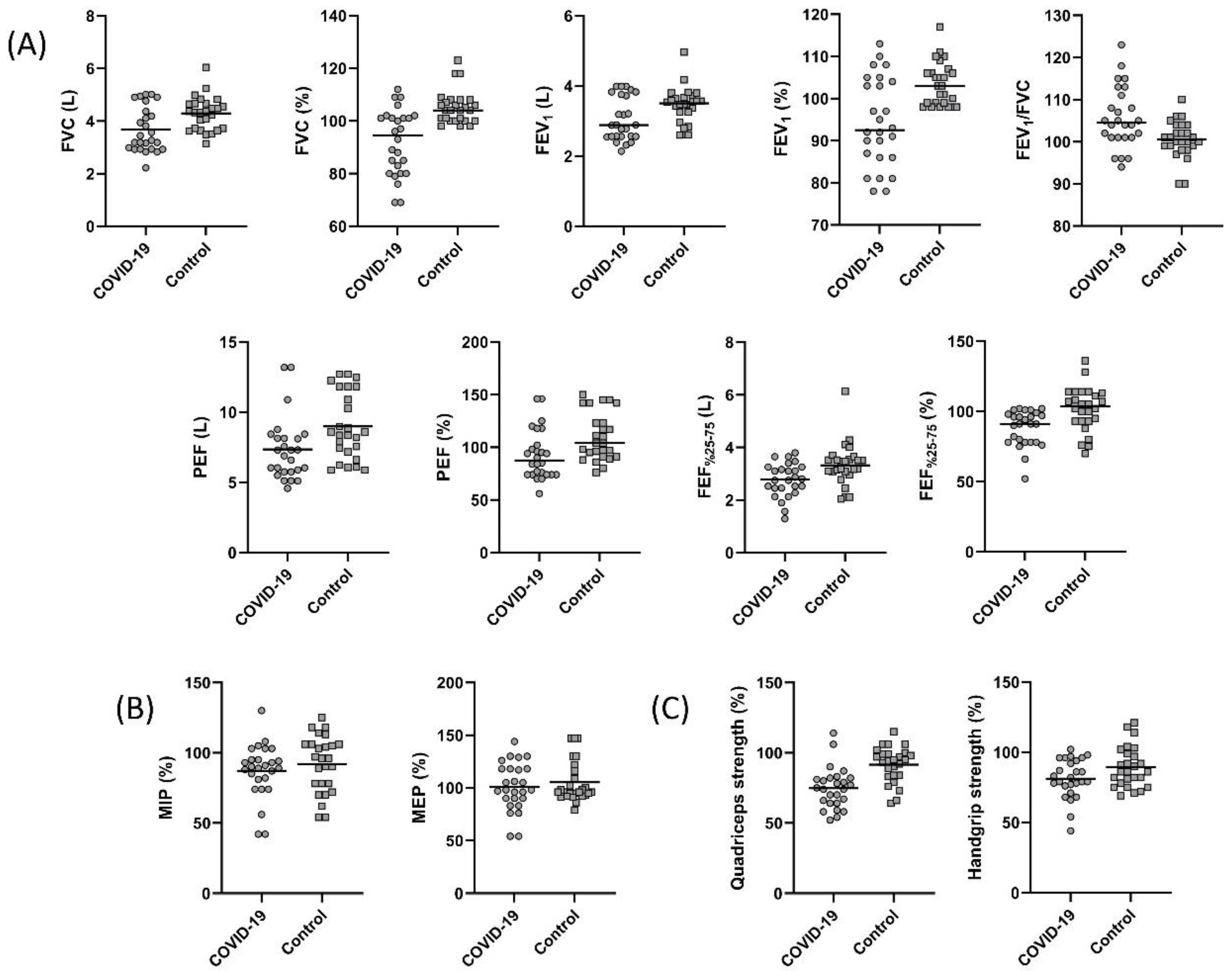
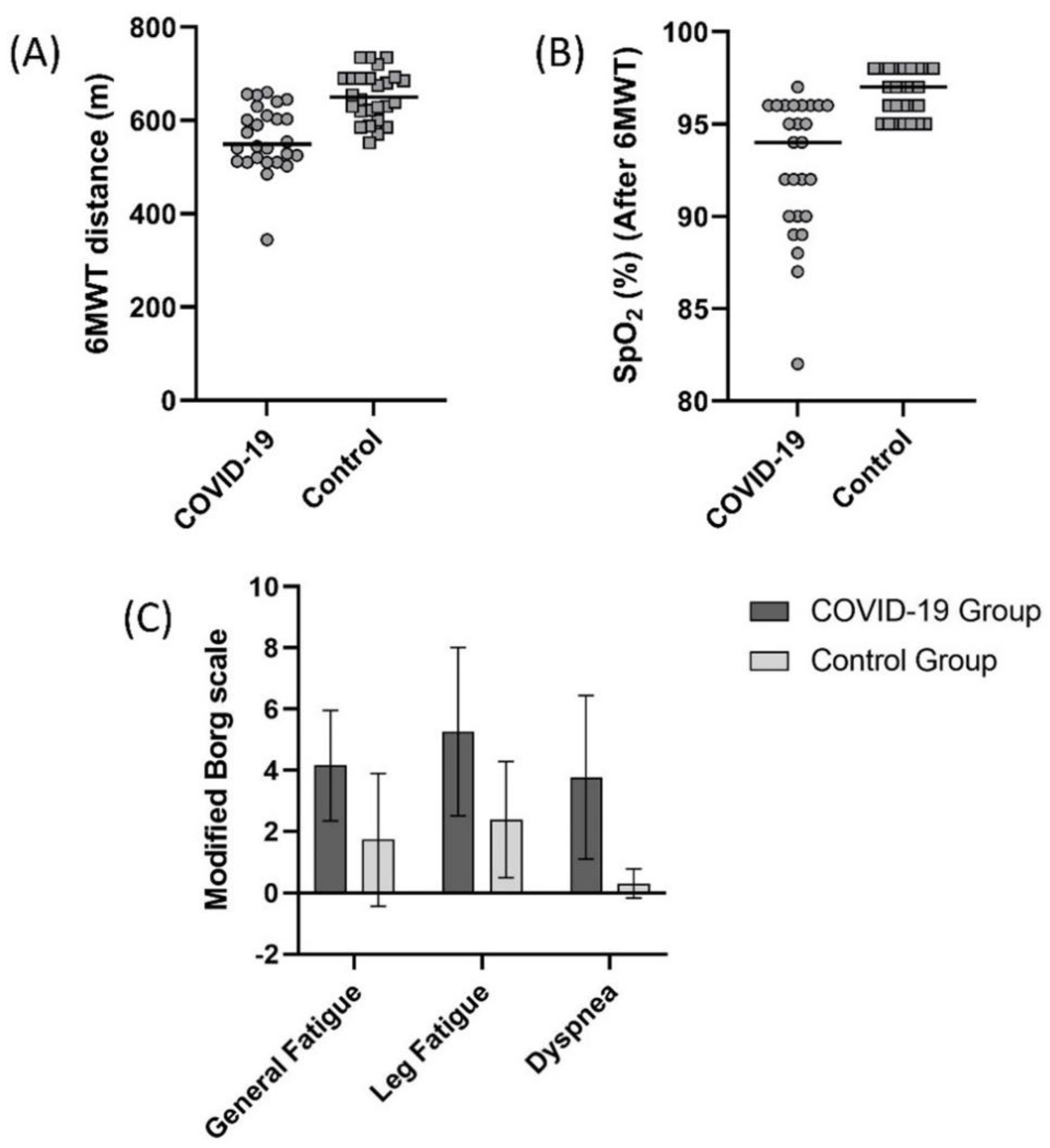
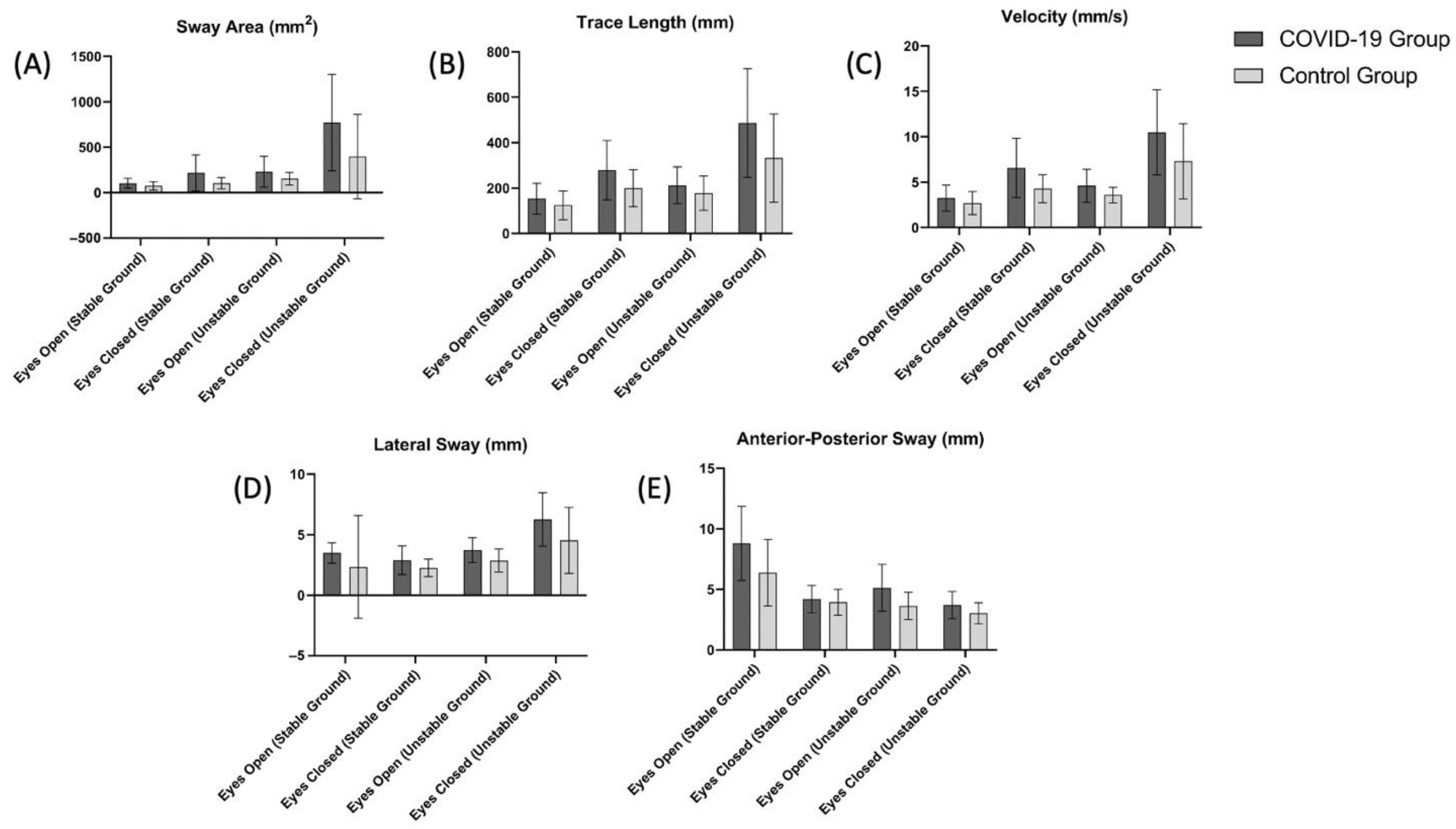
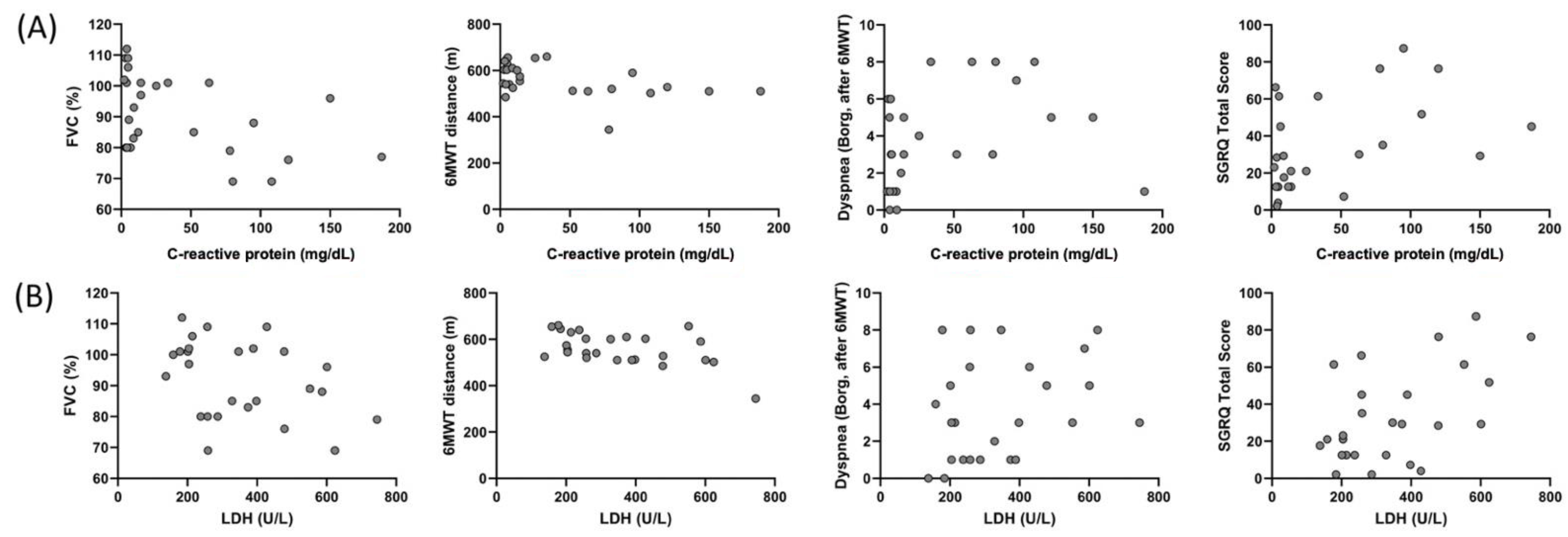
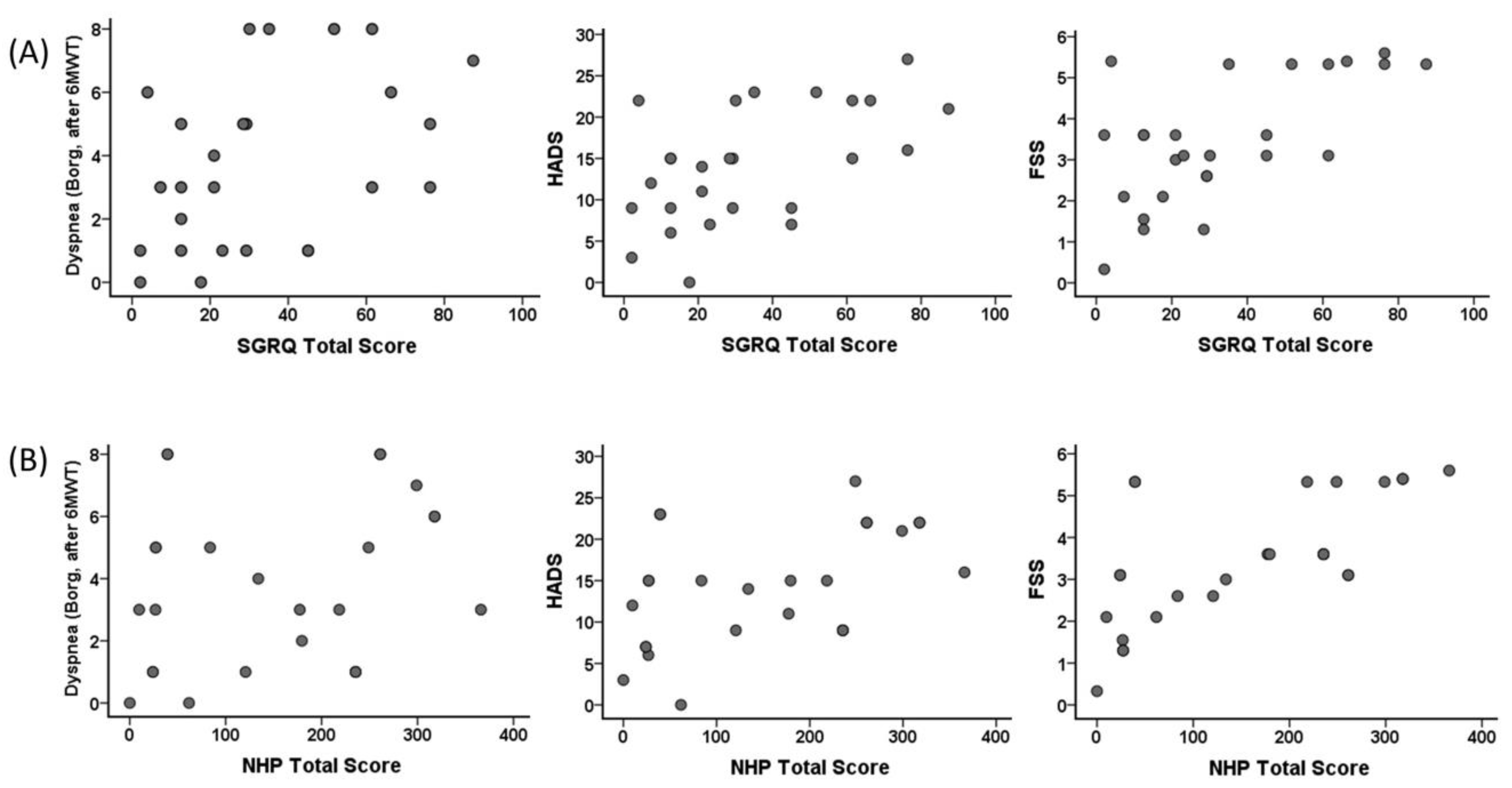
| Parameter a | COVID-19 Group (n = 26) | Control Group (n = 26) | p |
|---|---|---|---|
| Mean ± SD | Mean ± SD | ||
| Age (years) | 50.0 ± 13.8 | 47.0 ± 12.6 | 0.41 |
| Height (cm) | 171.2 ± 9.3 | 171.0 ± 7.0 | 0.89 |
| Weight (kg) | 79.1 ± 15.5 | 73.8 ± 13.8 | 0.20 |
| BMI (kg/m2) | 27.1 ± 5.9 | 25.1 ± 3.7 | 0.15 |
| MMRC score | 0.6 ± 0.5 | 0.1 ± 0.3 | <0.001 * |
| Smoking (pack-years) | 19.2 ± 15.3 | 20.0 ± 8.1 | 0.90 |
| Number of active smokers | 10 | 7 |
| Variables | COVID-19 Group (n = 26) | Control Group (n = 26) | p |
|---|---|---|---|
| Median (Min-Max) | Median (Min-Max) | ||
| HADS a,c | 14.2 ± 7.0 | 5.9 ± 3.6 | <0.001 * |
| FSS a,c | 3.5 ± 1.5 | 1.2 ± 0.7 | <0.001 * |
| MMST total score a,c | 27.7 ± 2.8 | 28.2 ± 1.5 | 0.42 |
| TUG a,c | 7.9 ± 1.2 | 7.2 ± 0.9 | 0.049 * |
| International Physical Activity Questionnaire b | |||
| High intensity (MET-min/week) | 0 (0–3360) | 0 (0–30240) | 0.10 |
| Medium intensity (MET-min/week) | 0 (0–3600) | 240 (0–1440) | 0.23 |
| Walking score (MET-min/week) | 1386 (132–2772) | 792 (0–11088) | 0.14 |
| Sitting score (MET-min/week) | 5 (3–6) | 5 (4–6) | 0.99 |
| Total score (MET-min/week) | 1391 (136–6736) | 929 (324–41333) | 0.08 |
| St George Respiratory Questionnaire b | |||
| Symptom | 30.5 (0–69.7) | 14.0 (0–40.4) | 0.01 * |
| Activity | 38.0 (0–95.6) | 0 (0–62.9) | <0.001 * |
| Impact | 16.7 (0–78.1) | 4.0 (0–15.0) | 0.001 * |
| Total Score | 28.9 (2.1–87.4) | 9.7 (0–30.0) | 0.001 * |
| Nottingham Health Profile b | |||
| Pain | 18.6 (0–89.5) | 0 (0–27.4) | 0.01 * |
| Emotional Reactions | 10.5 (0–92.8) | 0 (0–31.5) | 0.02 * |
| Sleep | 19.9 (0–61.5) | 0 (0–77.6) | 0.42 |
| Social Isolation | 0 (0–77.5) | 0 (0–16.0) | 0.03 * |
| Physical Activity | 16.9 (0–41.9) | 0 (0–22.0) | <0.001 * |
| Energy | 24 (0–100.0) | 0 (0–36.8) | <0.001 * |
| Total Score | 155.6 (0–366.0) | 30.6 (0–130.9) | 0.001 * |
| Parameter | Receiving Steroid Therapy (n = 15) | Not Receiving Steroid Therapy (n = 11) | p | NIMV (n = 12) | IMV (n = 14) | p |
|---|---|---|---|---|---|---|
| Median (Min-Max) | Median (Min-Max) | Median (Min-Max) | Median (Min-Max) | |||
| FVC (%) b | 83.0 (69.0–102.0) | 101.0 (89.0–112.0) | 0.001 * | 101.0 (80.0–112.0) | 84.0 (69.0–102.0) | 0.004 * |
| FEV1 (%) b | 90.0 (78.0–108.0) | 103.0 (87.0–113.0) | 0.008 * | 100.0 (81.0–113.0) | 90.0 (78.0–108.0) | 0.04 * |
| FEV1/FVC b | 105.0 (101.0–123.0) | 101.0 (94.0–113.0) | 0.01 * | 101.0 (94.0–113.0) | 106.5 (101.0–123.0) | 0.02 * |
| 6MWT distance (m) a,c | 532.7 ± 68.5 | 599.9 ± 56.2 | 0.01 * | 603.2 ± 54.8 | 525.1 ± 64.1 | 0.003 * |
| SpO2 (after 6MWT) (%) a,c | 92.0 (82.0–96.0) | 95.0 (90.0–97.0) | 0.04 * | 95.5 (90.0–97.0) | 91.0 (82.0–96.0) | 0.01 * |
| Length of stay in the ICU (days) a,c | 9.9 ± 7.9 | 4.1 ± 3.9 | 0.02 * | 3.8 ± 3.8 | 10.5 ± 7.8 | 0.01 * |
| APACHE II a,c | 15.5 ± 7.0 | 10.1 ± 5.5 | 0.046 * | 9.9 ± 5.3 | 16 ± 6.9 | 0.02 * |
| Parameter d | Length of Stay in the Intensive Care Unit | APACHE II Scores | Time Up Go Test | |||
|---|---|---|---|---|---|---|
| r | p | r | p | r | p | |
| Vaccination status | −0.633 | 0.001 * | −0.426 | 0.03 * | 0.298 | 0.14 |
| Time Up Go Test | −0.095 | 0.64 | 0.015 | 0.94 | - | - |
| MMRC | 0.327 | 0.10 | 0.368 | 0.06 | 0.221 | 0.28 |
| FVC | −0.564 | 0.003 * | −0.455 | 0.02 * | −0.442 | 0.02 * |
| FEV1 | −0.453 | 0.02 * | −0.315 | 0.12 | −0.546 | 0.004 * |
| 6MWT distance | −0.427 | 0.03 * | −0.449 | 0.02 * | −0.075 | 0.72 |
| ΔSpO2 | 0.469 | 0.02 * | 0.417 | 0.03 * | −0.242 | 0.23 |
| Handgrip strength | −0.487 | 0.01 * | −0.330 | 0.10 | −0.295 | 0.14 |
| HADS | 0.394 | 0.047 * | 0.394 | 0.046 * | 0.102 | 0.62 |
| NHP Total Score | 0.039 | 0.85 | 0.131 | 0.52 | 0.494 | 0.01 * |
| NHP Pain | 0.232 | 0.25 | 0.169 | 0.41 | 0.146 | 0.48 |
| NHP Emotional Reactions | −0.118 | 0.57 | 0.052 | 0.80 | 0.418 | 0.03 * |
| NHP Sleep | 0.018 | 0.93 | 0.122 | 0.55 | 0.555 | 0.003 * |
| NHP Social Isolation | −0.132 | 0.52 | −0.120 | 0.56 | −0.030 | 0.89 |
| NHP Physical Activity | 0.104 | 0.61 | 0.259 | 0.20 | 0.490 | 0.01 * |
| NHP Energy | 0.086 | 0.67 | 0.142 | 0.49 | 0.353 | 0.08 |
| SGRQ Total Score | 0.568 | 0.002 * | 0.372 | 0.06 | 0.112 | 0.59 |
| SGRQ Symptom | 0.551 | 0.004 * | 0.339 | 0.09 | 0.101 | 0.62 |
| SGRQ Activity | 0.532 | 0.005 * | 0.396 | 0.045 * | 0.133 | 0.52 |
| SGRQ Impact | 0.573 | 0.002 * | 0.428 | 0.03 * | 0.074 | 0.72 |
| Parameter | Mean ± SD | Changes with Reference Value |
|---|---|---|
| Hematologic | ||
| White blood cell count (103/µL) | 8.4 ± 3.6 | ↔ |
| Neutrophil (%) | 61.8 ± 10.5 | ↔ |
| Lymphocyte (%) | 18.1 ± 11.5 | ↔ |
| Hemoglobin (g/dL) | 11.0 ± 2.3 | ↓ |
| Hematocrit (%) | 37 ± 4.5 | ↓ |
| Platelet count (103/µL) | 201.7 ± 65.6 | ↔ |
| Biochemical | ||
| Lactate dehydrogenase (U/L) | 350.4 ± 167.2 | ↑ |
| Creatine kinase-MB (U/L) | 33.2 ± 12.9 | ↑ |
| Aspartate aminotransferase (U/L) | 62.9 ± 51.8 | ↑ |
| Alanine aminotransferase (U/L) | 59.0 ± 56.7 | ↑ |
| Troponin T (ng/L) | 30.1 ± 33.4 | ↑ |
| Kreatinin (mg/dL) | 1.4 ± 0.8 | ↑ |
| Coagulation | ||
| Prothrombin time (sn) | 16.8 ± 2.4 | ↑ |
| D-dimer (µg/L) | 829.9 ± 1027.5 | ↑ |
| Inflammatory biomarkers | ||
| Ferritin (µg/L) | 343.5 ± 184.4 | ↑ |
| C-reactive protein (mg/L) | 42.3 ± 46.5 | ↑ |
| Erythrocyte sedimentation rate (mm/h) | 16.8 ± 8.8 | ↑ |
Publisher’s Note: MDPI stays neutral with regard to jurisdictional claims in published maps and institutional affiliations. |
© 2022 by the authors. Licensee MDPI, Basel, Switzerland. This article is an open access article distributed under the terms and conditions of the Creative Commons Attribution (CC BY) license (https://creativecommons.org/licenses/by/4.0/).
Share and Cite
Sirayder, U.; Inal-Ince, D.; Kepenek-Varol, B.; Acik, C. Long-Term Characteristics of Severe COVID-19: Respiratory Function, Functional Capacity, and Quality of Life. Int. J. Environ. Res. Public Health 2022, 19, 6304. https://doi.org/10.3390/ijerph19106304
Sirayder U, Inal-Ince D, Kepenek-Varol B, Acik C. Long-Term Characteristics of Severe COVID-19: Respiratory Function, Functional Capacity, and Quality of Life. International Journal of Environmental Research and Public Health. 2022; 19(10):6304. https://doi.org/10.3390/ijerph19106304
Chicago/Turabian StyleSirayder, Ukbe, Deniz Inal-Ince, Busra Kepenek-Varol, and Cihangir Acik. 2022. "Long-Term Characteristics of Severe COVID-19: Respiratory Function, Functional Capacity, and Quality of Life" International Journal of Environmental Research and Public Health 19, no. 10: 6304. https://doi.org/10.3390/ijerph19106304
APA StyleSirayder, U., Inal-Ince, D., Kepenek-Varol, B., & Acik, C. (2022). Long-Term Characteristics of Severe COVID-19: Respiratory Function, Functional Capacity, and Quality of Life. International Journal of Environmental Research and Public Health, 19(10), 6304. https://doi.org/10.3390/ijerph19106304






